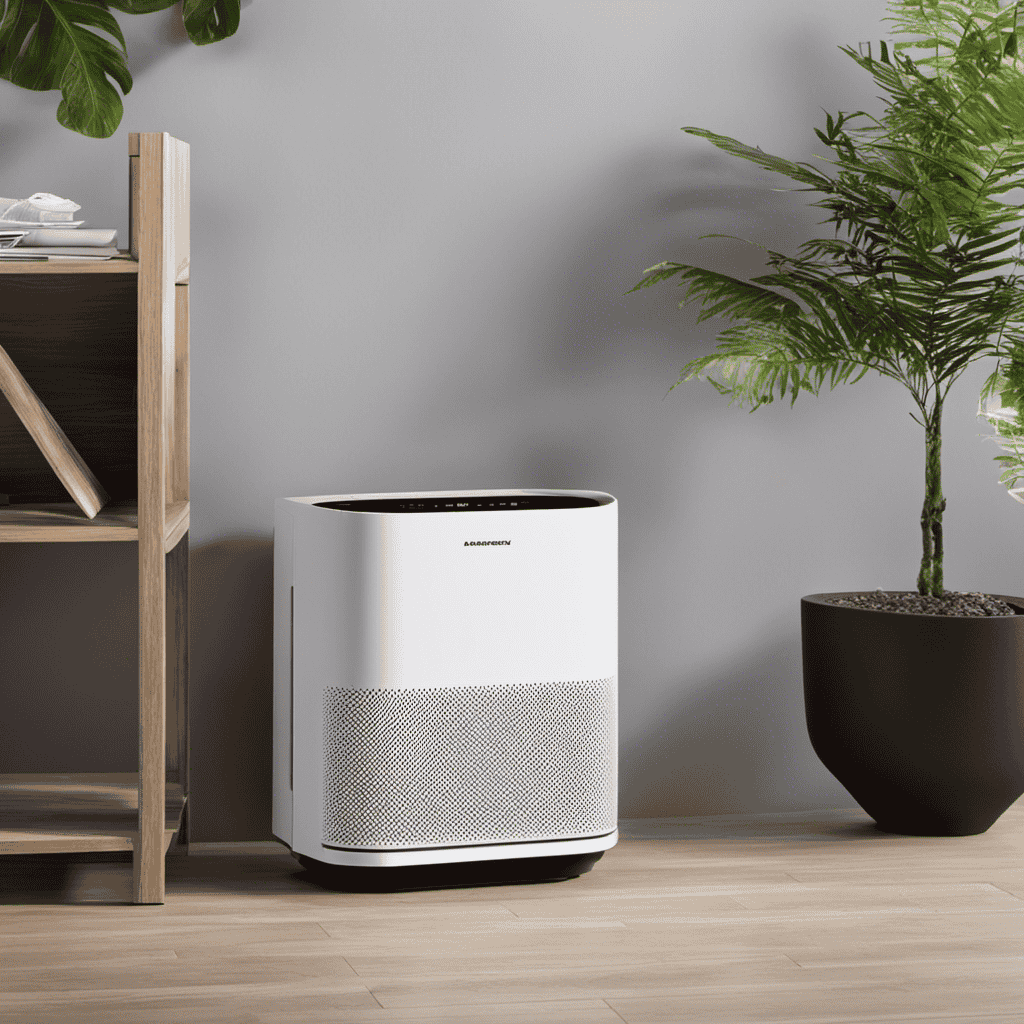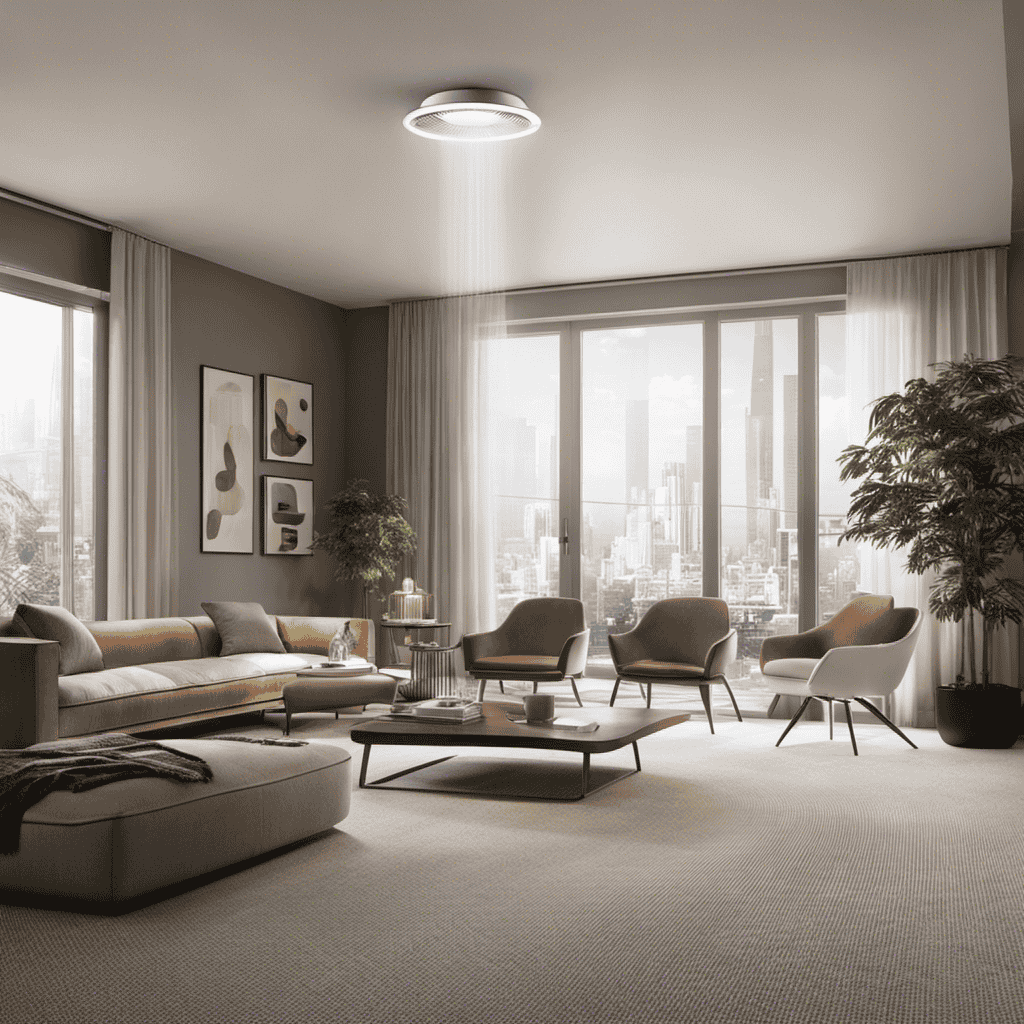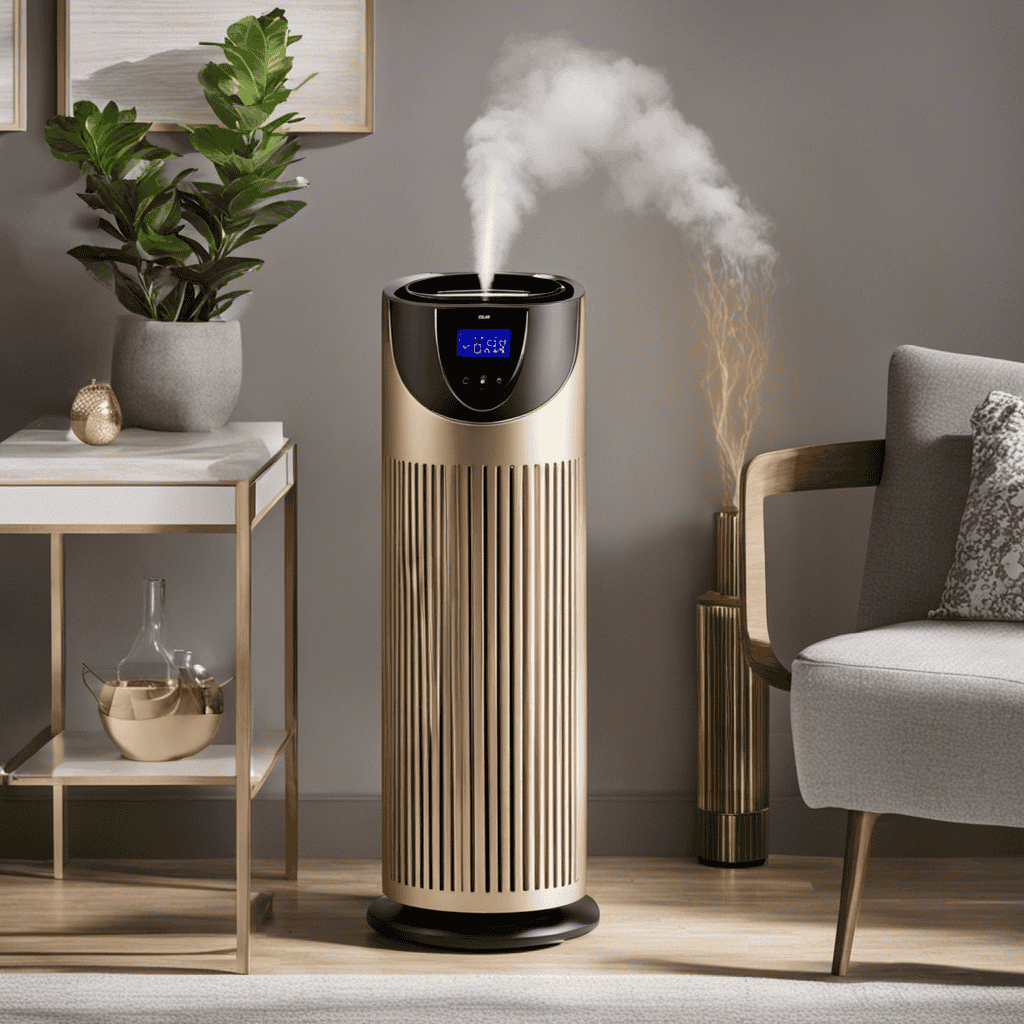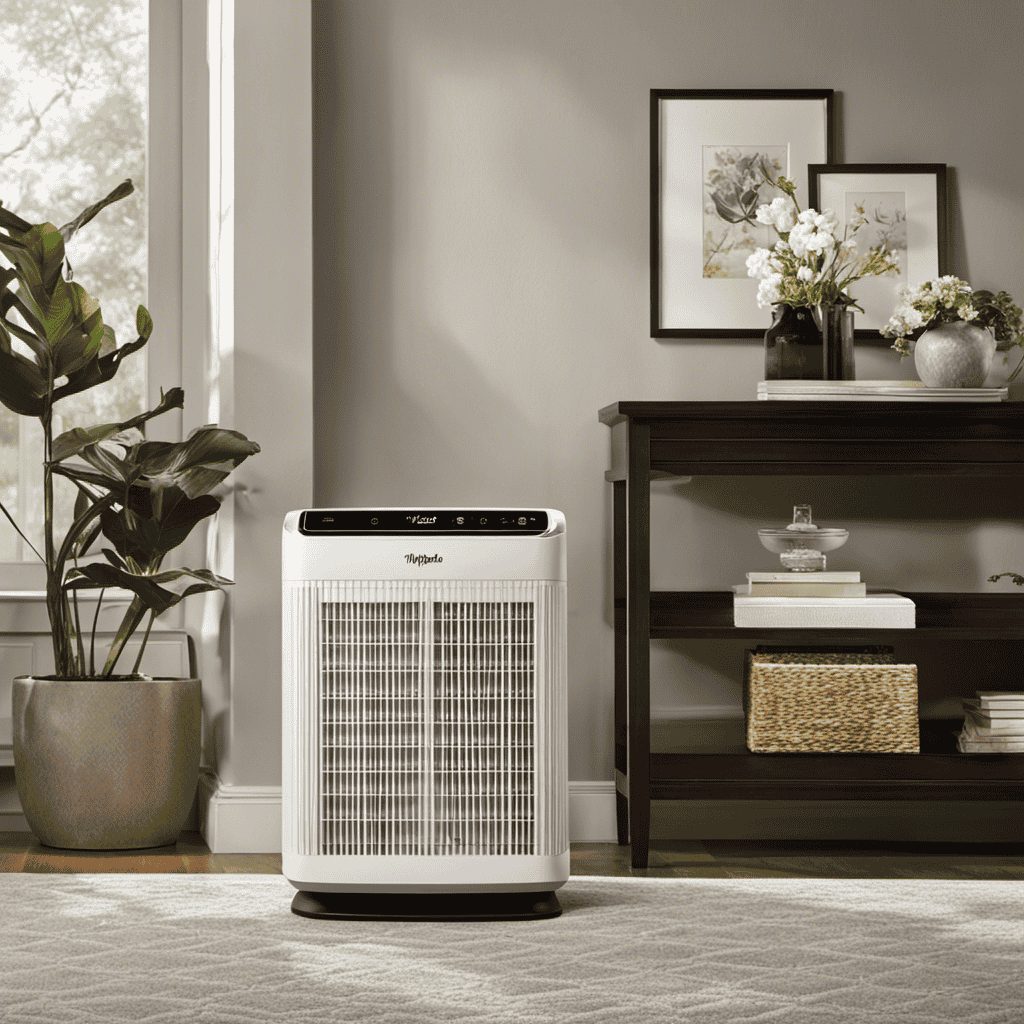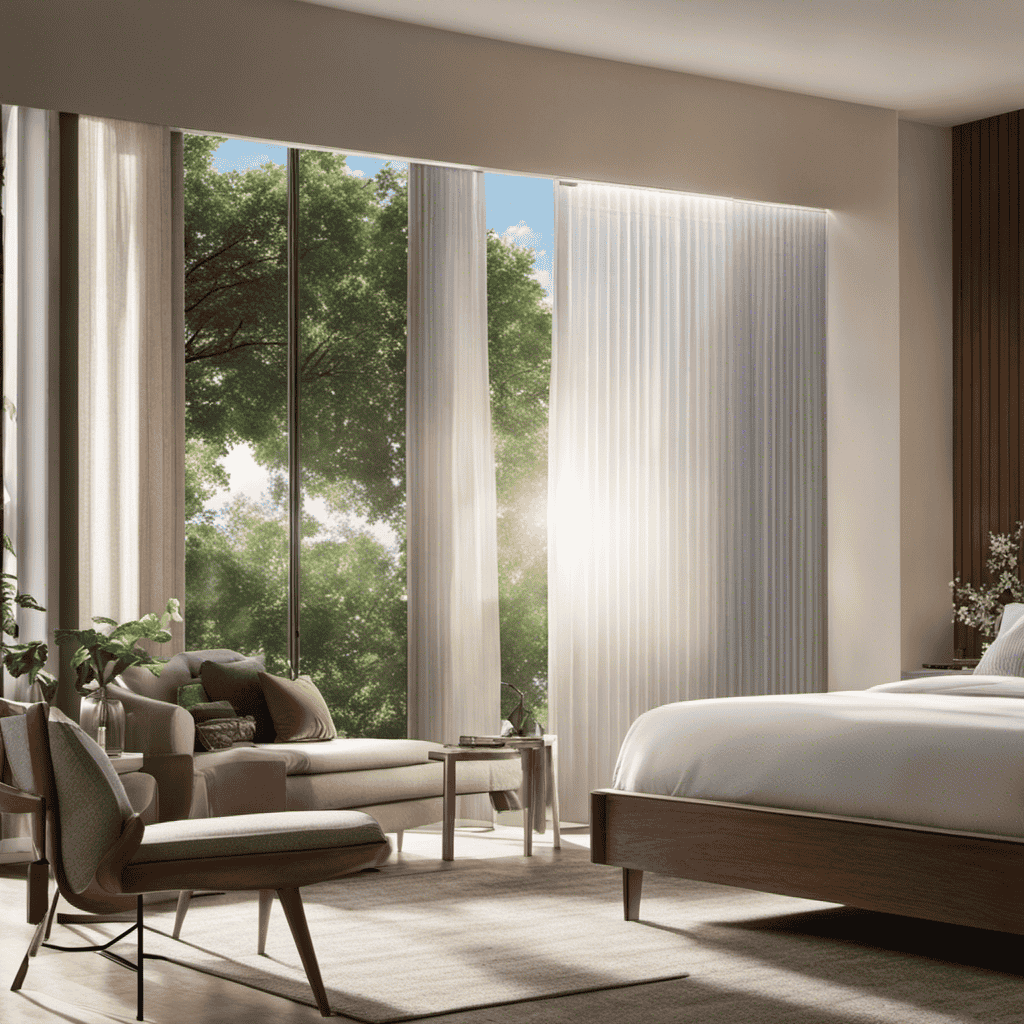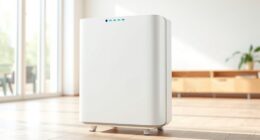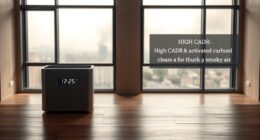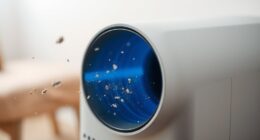Hello there!
Wondering how often you should change your air purifier filter? Well, look no further because I’ve got all the answers for you.
In this article, I’ll be diving into the importance of regular filter changes, factors that affect filter lifespan, manufacturer recommendations, signs that indicate it’s time for a replacement, and so much more.
So, sit back, relax, and let’s get to the bottom of this air purifier filter dilemma together!
Key Takeaways
- Regular filter changes maintain the effectiveness of the air purifier.
- Clean filters improve air quality and reduce respiratory problems.
- Regularly changing the filter ensures optimal performance.
- Timely filter replacement ensures the effectiveness of the purifier.
The Importance of Regular Filter Changes
Regular filter changes are essential for maintaining the effectiveness of your air purifier. The performance of your air purifier’s filter can be affected by various factors.
One important factor is the level of air pollution in your environment. If you live in an area with high levels of pollution, your filter will get dirty more quickly and will need to be changed more often.
Another factor is the size of your air purifier and the size of its filter. Smaller purifiers with smaller filters may need to be changed more frequently as they have less capacity to trap pollutants.
Regular filter changes offer many benefits, such as improved air quality and reduced respiratory problems. Clean filters ensure that your air purifier can effectively remove allergens, dust, pet dander, and other harmful particles from the air you breathe.
Factors Affecting Air Purifier Filter Lifespan
When it comes to the lifespan of an air purifier filter, there are several key factors to consider.
One important factor is the usage and environment impact on the filter. Factors such as the number of hours the air purifier is running, the presence of pollutants in the surrounding area, and the overall air quality can all have an impact on the filter’s lifespan.
Additionally, the quality and maintenance of the filter itself play a significant role in how long it will last. Regular cleaning and proper maintenance can help extend the lifespan of the filter, while using a high-quality filter in the first place can also make a difference.
Lastly, the level of air quality in the environment can also affect the filter’s lifespan. If the air is heavily polluted, the filter may need to work harder and may need to be replaced more frequently.
Usage and Environment Impact
The usage and environment impact of air purifier filters can vary depending on factors such as air quality and frequency of use. To optimize the lifespan of air purifier filters, it is important to understand how they are affected by these factors.
When it comes to usage, filters that are used in heavily polluted areas or in homes with pets may need to be replaced more frequently. Additionally, filters that are used for longer durations or at higher fan speeds may also wear out faster. On the other hand, filters used in cleaner environments or with less frequent use may last longer.
In terms of the environment impact, eco-friendly filter options are available that are made from sustainable materials and can be recycled. These filters not only contribute to reducing waste, but also help maintain cleaner air for longer periods of time.
Filter Quality and Maintenance
To ensure optimal performance, you should regularly clean and maintain your air purifier’s filter. Proper filter maintenance is crucial for filter longevity and to ensure that your air purifier continues to effectively remove pollutants from the air. Here are some essential filter maintenance techniques to keep in mind:
- Vacuum the filter regularly to remove dust and debris.
- Rinse the filter with water to remove trapped particles.
- Allow the filter to dry completely before reinstalling.
- Replace the filter according to the manufacturer’s recommendations.
- Consider using a pre-filter to extend the life of your main filter.
By following these filter maintenance techniques, you can prolong the lifespan of your air purifier’s filter and ensure that it continues to provide you with clean and fresh air.
Air Quality Level
Maintaining a clean and healthy environment is crucial for optimal air quality. Air pollution is a significant concern, as it can lead to various health issues, including respiratory problems and allergies.
Fortunately, using an air purifier can help alleviate these concerns and provide several health benefits. Air purifiers work by filtering out pollutants and contaminants from the air, ensuring that the air we breathe is clean and safe.
By removing harmful particles, such as dust, pollen, and pet dander, air purifiers can reduce the risk of allergies and asthma attacks. Additionally, they can also eliminate odors and harmful chemicals, creating a more pleasant and healthier living environment.
To ensure the efficiency of your air purifier, it is vital to follow the manufacturer’s recommendations for filter replacement, which we will discuss in the next section.
Manufacturer Recommendations for Filter Replacement
Make sure you follow the manufacturer’s recommendations for replacing your air purifier filter regularly. This is crucial to maintain optimal air quality and ensure the effectiveness of your air purifier.
Here are some discussion ideas regarding filter replacement:
-
Filter replacement frequency guidelines: Manufacturers typically recommend replacing the filters every 6 to 12 months, depending on usage and air quality.
-
Cost-effective alternatives to manufacturer recommended filters: Look for compatible filters from reputable third-party brands that offer similar performance at a lower cost.
-
DIY options: Some filters can be cleaned and reused, saving you money in the long run.
-
Filter subscription services: Consider subscribing to filter replacement services that deliver new filters to your doorstep on a regular schedule, ensuring you never forget to replace them.
-
Extended filter lifespan: Regularly vacuuming or dusting the pre-filter can help extend the lifespan of the main filter, reducing the frequency of replacements.
Signs That Your Air Purifier Filter Needs Changing
When it comes to knowing when to change your air purifier filter, there are a few key indicators to keep an eye out for.
First, if you start noticing a foul odor coming from your air purifier, it’s a definite sign that the filter needs to be replaced.
Additionally, if you notice a decrease in airflow or a weaker fan speed, it’s a good indication that the filter is clogged and in need of a change.
Finally, visual dirt accumulation on the filter itself is a clear signal that it’s time to replace it.
Foul Odor Indicates Replacement
If you notice a foul odor coming from your air purifier, it’s time to replace the filter. A bad smell indicates that the air purifier filter is no longer effectively removing the pollutants from the air.
Here are the benefits of regularly replacing your air purifier filter:
-
Improved Indoor Air Quality: By changing the filter, you ensure that your air purifier continues to effectively remove dust, pollen, pet dander, and other contaminants from the air, resulting in cleaner and healthier indoor air.
-
Allergy Relief: A clean filter helps reduce allergens in the air, providing relief for those with allergies or asthma.
-
Increased Energy Efficiency: A clogged filter can make your air purifier work harder, consuming more energy. Replacing the filter helps maintain the efficiency of the device.
-
Prolonged Lifespan: Regular filter maintenance ensures the longevity of your air purifier, saving you money in the long run.
-
Peace of Mind: Knowing that your air purifier is functioning optimally and providing clean air gives you peace of mind and promotes a healthier living environment.
Regular air purifier filter maintenance is crucial for reaping these benefits and ensuring the effectiveness of your air purifier.
Decreased Airflow Means Change
A decrease in airflow signals that it’s time for a filter replacement. When the airflow in an air purifier starts to decrease, it means that the filter is becoming clogged with particles and contaminants. This not only affects the performance of the air purifier but also reduces its ability to effectively clean the air. Regularly changing the air purifier filter is important to maintain optimal performance and ensure clean, healthy air in your home or office.
To illustrate the importance of filter replacement, let’s consider some cost considerations and health benefits.
| Cost Considerations | Health Benefits |
|---|---|
| Regular filter changes can seem costly upfront | Improved indoor air quality |
| However, clogged filters can lead to increased energy consumption | Reduced allergy symptoms |
| and potential damage to the air purifier itself | Decreased respiratory issues |
| Longer filter lifespan can result in lower long-term costs | Enhanced overall well-being |
| Choose filters with longer lifespans for cost savings | Promote a healthier living environment |
Visual Dirt Accumulation Signals Replacement
The visual accumulation of dirt on the surface indicates that it’s time to replace the filter. When it comes to air purifiers, frequent filter replacement is crucial for optimal performance. Regular visual inspections are necessary to ensure the filter is clean and functioning effectively. Here are five reasons why you should pay attention to visual dirt accumulation and replace your air purifier filter promptly:
-
Improved air quality: A clean filter ensures that your air purifier can effectively remove pollutants, allergens, and odors, providing you with clean and fresh air.
-
Enhanced energy efficiency: A clogged filter obstructs airflow, forcing the air purifier to work harder and consume more energy. Replacing the filter helps maintain energy efficiency.
-
Prolonged lifespan: By replacing the filter regularly, you can extend the lifespan of your air purifier, saving you money in the long run.
-
Allergy relief: A dirty filter can exacerbate allergy symptoms. Replacing it ensures that your air purifier is effectively capturing and trapping allergens, providing relief.
-
Peace of mind: Knowing that you have a clean filter gives you peace of mind, knowing that you are breathing in clean, purified air.
Remember to visually inspect your air purifier filter regularly and replace it when you notice dirt accumulation to enjoy the full benefits of your air purifier.
How Often Should You Check Your Air Purifier Filter
You should regularly check your air purifier filter to ensure it is working efficiently. The lifespan of an air purifier filter can vary depending on several factors.
The first factor is the type of filter you have. HEPA filters, for example, typically last around six to twelve months, while carbon filters may need to be replaced every three months.
Another factor that affects the filter’s lifespan is the air quality in your home. If you live in an area with high levels of pollution or allergens, the filter may get clogged more quickly.
Signs that your air purifier filter needs to be replaced include reduced airflow, a noticeable increase in dust or odors, and a decrease in the overall effectiveness of the purifier.
Can You Extend the Lifespan of Your Air Purifier Filter
To prolong the lifespan of your air purifier filter, it’s important to regularly clean and maintain it. Here are some effective ways to take care of your filter:
- Vacuum the filter: Gently vacuum the surface of the filter to remove large particles and debris.
- Wash with water: If your filter is washable, rinse it under running water to remove trapped dust and dirt.
- Use a soft brush: Use a soft brush to gently dislodge any stubborn particles from the filter.
- Allow it to dry: After cleaning, make sure the filter is completely dry before reinserting it into the air purifier.
- Consider investing in a pre-filter: A pre-filter can help trap larger particles, reducing the workload on the main filter.
Regular filter cleaning not only improves the efficiency of your air purifier, but it also saves you money on filter replacement costs. By properly maintaining your filter, you can extend its lifespan and ensure optimal performance.
Now, let’s discuss common mistakes to avoid when changing air purifier filters.
Common Mistakes to Avoid When Changing Air Purifier Filters
When changing your air purifier filters, it’s important to avoid these common mistakes.
Neglecting to change the filters regularly can significantly reduce their efficiency in capturing airborne particles. One of the factors affecting filter efficiency is the accumulation of dirt and debris. If the filters are not replaced or cleaned, they can become clogged and restrict airflow, making the air purifier work harder and reducing its effectiveness.
Another mistake is using the wrong type of filter for your specific air purifier model. Each air purifier has specific filter requirements, and using the wrong filter can result in poor performance and reduced filtration.
Additionally, failing to properly install the filters can lead to air leakage and bypassing, rendering the air purifier ineffective. Therefore, it’s crucial to follow the manufacturer’s instructions and guidelines when replacing your air purifier filters to ensure optimal performance and clean air in your home.
Understanding the Different Types of Air Purifier Filters
When it comes to air purifier filters, there are a few key points to consider.
Firstly, understanding the lifespan and effectiveness of your filter is crucial in ensuring that your air purifier is working at its best.
Secondly, choosing the right filter for your specific needs and preferences is also important. This can greatly impact the quality of air in your home.
Lastly, proper maintenance and timely replacement of filters will help to ensure the longevity and efficiency of your air purifier.
Filter Lifespan and Effectiveness
You should regularly check the lifespan and effectiveness of your air purifier filter. It’s important to maintain a clean and functioning filter to ensure that your air purifier is working at its optimal level.
There are several factors that can affect the effectiveness of your filter, such as the level of pollutants in your environment, the size of the particles being filtered, and the frequency of use. By keeping your filter clean and replacing it when necessary, you can enjoy the benefits of a clean air purifier filter, including improved indoor air quality, reduced allergens and respiratory irritants, and a healthier living environment.
Regularly checking and maintaining your filter will help to ensure that your air purifier continues to provide you with clean and fresh air.
Choosing the Right Filter
To ensure optimal performance, it’s essential to select the right filter for your air purifier. When it comes to filter selection, there are a few key factors to consider.
First and foremost is filter efficiency. This refers to how well the filter can capture and remove particles from the air. The higher the efficiency, the better the filter will be at trapping contaminants like dust, pollen, and pet dander. It’s important to choose a filter with a high efficiency rating, such as HEPA filters, which can capture up to 99.97% of particles as small as 0.3 microns.
Other factors to consider include the type of filter (e.g., activated carbon for odor removal), the size of the filter (to ensure it fits your air purifier), and the recommended filter change frequency.
Maintenance and Replacement Tips
When it comes to maintaining and replacing your air purifier filter, there are a few important things to keep in mind. Regular DIY maintenance is crucial to ensure that your air purifier is working efficiently and effectively.
Here are some tips to help you stay on top of your filter replacement schedule:
-
Check your filter regularly: Keep an eye on the condition of your filter and look for any signs of dirt or debris buildup.
-
Follow manufacturer guidelines: Different air purifiers have different filter replacement schedules, so it’s important to follow the recommendations provided by the manufacturer.
-
Consider your environment: If you live in a particularly dusty or polluted area, you may need to replace your filter more frequently.
-
Keep spare filters on hand: Having extra filters ready to go will make it easier to stay on top of regular replacements.
-
Don’t overlook cleaning: In addition to replacing your filter, it’s also important to clean other parts of your air purifier regularly to maintain its overall performance.
By following these maintenance and replacement tips, you can ensure that your air purifier is always running at its best.
Now, let’s dive into how to properly clean and maintain your air purifier filter.
How to Properly Clean and Maintain Your Air Purifier Filter
If properly maintained, cleaning your air purifier filter regularly will ensure its effectiveness and longevity. Proper cleaning techniques are essential to keep your air purifier working at its best.
One common mistake people make is not cleaning the filter frequently enough. Depending on the model and usage, it is usually recommended to clean the filter every 2-3 months. To clean the filter, remove it from the purifier and gently vacuum or wash it with mild soap and water. Make sure to let it dry completely before reinstalling it.
Another mistake is using harsh chemicals or excessive force when cleaning, which can damage the filter. By following these proper cleaning techniques, you can prolong the life of your air purifier filter and maintain its optimal performance.
Now let’s explore the options for DIY vs. professional air purifier filter replacement.
DIY Vs. Professional Air Purifier Filter Replacement
When it comes to replacing your air purifier filter, there are cost-effective options available that can help you save money in the long run.
It’s important to consider the maintenance requirements for longevity, as properly caring for your filter can extend its lifespan and ensure optimal performance.
In this discussion, I will explore the various cost-effective options for replacement and provide valuable insights on maintenance requirements to help you make informed decisions.
Cost-Effective Options for Replacement
There are cost-effective options available for replacing the air purifier filter. When it comes to saving money on filter replacements, consider these alternative filter options:
-
Washable Filters: These reusable filters can be cleaned and reused multiple times, reducing the need for frequent replacements.
-
Generic Filters: Look for generic filters that are compatible with your air purifier model. They are often more affordable without compromising on quality.
-
Subscription Services: Some companies offer filter subscription services, delivering new filters to your doorstep at regular intervals, saving you time and money.
-
DIY Filter Refills: Instead of buying pre-made filters, you can purchase filter media and refill your existing filter frame, saving on costs.
-
Filter Rejuvenators: These products help extend the lifespan of your filter by cleaning and restoring its efficiency.
By exploring these cost-saving options, you can maintain a clean and healthy indoor environment without breaking the bank.
Now, let’s discuss the maintenance requirements for longevity.
Maintenance Requirements for Longevity
When it comes to maintaining the longevity of your air purifier filter, regular maintenance is key. By properly caring for your filter, you can ensure its effectiveness and extend its lifespan. Filter maintenance includes cleaning and replacing the filter as needed. The frequency of filter replacement depends on several factors, such as the type of filter, the air quality in your environment, and the manufacturer’s recommendations. To help you understand the general guidelines for filter replacement, here is a table summarizing the recommended filter replacement frequencies for different types of filters:
| Filter Type | Replacement Frequency |
|---|---|
| Pre-filter | Every 3 months |
| HEPA filter | Every 6 to 12 months |
| Carbon filter | Every 6 to 12 months |
| UV-C filter | Every 6 to 12 months |
| Ionizer | Every 6 to 12 months |
Understanding the maintenance requirements and recommended filter replacement frequencies is crucial in ensuring that your air purifier operates at its best. However, it’s important to note that the role of air quality in determining filter replacement frequency should also be considered.
The Role of Air Quality in Determining Filter Replacement Frequency
The quality of the air directly affects how often you need to change the air purifier filter. Several factors can impact the frequency of filter replacement.
Here are some key points to consider:
-
Air pollution levels: High levels of pollutants in the air can quickly clog up the filter, reducing its effectiveness and requiring more frequent replacement.
-
Indoor activities: Certain activities like cooking, smoking, or using chemicals can release particles into the air, increasing the workload on the filter.
-
Pet dander and allergens: If you have pets or suffer from allergies, the filter may need to be changed more frequently to maintain clean air.
-
Seasonal changes: Different seasons bring different allergens and pollutants, so filter replacement frequency may need to be adjusted accordingly.
-
Filter quality: The type and quality of the filter itself can also affect its lifespan and the need for replacement.
Understanding these factors and their impact on filter lifespan can help you determine how often you should change your air purifier filter for optimal air quality.
How to Choose the Right Air Purifier Filter for Your Needs
To determine the appropriate air purifier filter for your needs, consider factors such as air quality requirements, allergens present, and the specific purifier model.
When choosing an air purifier filter, it’s important to consider the type of pollutants you want to remove from your indoor air. Factors such as the size of particles, such as dust or pollen, and the presence of volatile organic compounds (VOCs) should be taken into account.
Additionally, consider the specific purifier model you own, as different models may require different types of filters. One common misconception about air purifier filters is that they only need to be replaced when they are visibly dirty. However, it is recommended to follow the manufacturer’s guidelines for filter replacement, as a dirty filter can reduce the efficiency of the purifier.
Transitioning into the next section about the environmental impact of regular air purifier filter changes, it’s important to note that proper disposal of used filters is crucial to minimize their impact on the environment.
Environmental Impact of Regular Air Purifier Filter Changes
Properly disposing of used filters is crucial to minimize their impact on the environment, and it’s important to follow the manufacturer’s guidelines for replacement. When it comes to the environmental impact of filter disposal, there are several factors affecting filter efficiency that we should consider:
-
Material Composition: Filters made from synthetic materials like fiberglass or polyester are not biodegradable and can take hundreds of years to decompose.
-
Contaminant Accumulation: Filters collect pollutants and allergens over time, and improper disposal can release these harmful substances back into the environment.
-
Energy Consumption: Manufacturing new filters requires energy and resources, contributing to carbon emissions and environmental degradation.
-
Landfill Space: Improperly discarded filters take up valuable landfill space, which could be better used for other waste management purposes.
-
Water Contamination: Filters can contain hazardous substances that may leach into groundwater if not disposed of correctly.
Considering these factors, it is crucial to dispose of air purifier filters responsibly to minimize their environmental impact.
Now, let’s explore recommended filters for allergy and asthma sufferers.
Recommended Filters for Allergy and Asthma Sufferers
When selecting filters for allergy and asthma sufferers, it’s important to consider their level of effectiveness in removing airborne particles and allergens. Recommended filters for allergy and asthma sufferers are those that have a high filter effectiveness. These filters are designed to capture and remove a wide range of allergens and irritants from the air, including pollen, dust mites, pet dander, mold spores, and tobacco smoke.
HEPA filters are often recommended for allergy and asthma sufferers, as they are highly effective in removing airborne particles as small as 0.3 microns. Additionally, activated carbon filters can help remove odors and chemicals from the air.
It’s also important to regularly replace these filters to maintain their effectiveness in providing clean air for allergy and asthma sufferers.
Tips for Prolonging the Lifespan of Your Air Purifier Filter
One way to extend the lifespan of your air purifier filter is by regularly cleaning it. Keeping your filter clean not only improves the effectiveness of your air purifier but also saves you money in the long run.
Here are some maintenance tips to help you prolong the lifespan of your air purifier filter:
-
Vacuum the filter: Gently vacuuming the surface of the filter can remove larger particles and debris, reducing the strain on the filter.
-
Rinse with water: For washable filters, rinsing with water can help remove trapped dust and allergens.
-
Use a brush: Using a soft brush can help dislodge stubborn dirt and particles from the filter.
-
Allow the filter to dry completely: Make sure the filter is completely dry before reinstalling it to prevent mold and mildew growth.
-
Follow manufacturer’s instructions: Each air purifier may have specific maintenance recommendations, so it’s important to read and follow the manufacturer’s instructions.
What is the recommended frequency for changing an air purifier filter?
It is crucial to follow the manufacturer’s guidelines when it comes to changing air purifier filters often. Typically, it is recommended to replace the filter every 6 to 12 months, depending on usage and the air quality in your home. Not changing air purifier filters often enough can lead to decreased performance and air quality.
Frequently Asked Questions
Can I Use My Air Purifier Without a Filter?
Yes, you can use an air purifier without a filter, but it won’t be as effective. Filters trap pollutants and improve air quality, so using a filter provides the most benefits for cleaner and healthier air.
How Often Should I Clean My Air Purifier Filter?
I replace my air purifier filter every 3 to 6 months. To clean it effectively, I gently vacuum or rinse it with water. Regular maintenance ensures optimal performance and cleaner indoor air.
Are There Any Alternatives to Replacing the Air Purifier Filter?
There are alternative options to replacing the air purifier filter, such as DIY air filter options. These alternatives can be cost-effective and environmentally friendly solutions for maintaining clean air in your home.
What Are the Consequences of Not Changing the Air Purifier Filter Regularly?
Consequences of not changing the air purifier filter regularly include reduced effectiveness in filtering out pollutants, decreased indoor air quality, and potential health risks. It’s important to prioritize regular filter changes for optimal air purification.
Can I Use a Different Brand of Filter in My Air Purifier?
I haven’t experienced compatibility issues using different filter brands in my air purifier. However, it’s always best to check the manufacturer’s recommendations to ensure proper performance and filtration.
Conclusion
In conclusion, maintaining a regular schedule for changing your air purifier filter is crucial for maintaining clean and healthy indoor air. By following the manufacturer’s recommendations and checking your filter regularly, you can ensure that your air purifier is functioning at its best.
Don’t underestimate the impact of a clean filter on your respiratory health and overall well-being. Remember, choosing the right filter for your specific needs and taking steps to prolong its lifespan will not only benefit you but also contribute to a healthier environment.
So, take care of your air purifier filter, and breathe in the fresh, purified air with peace of mind.
